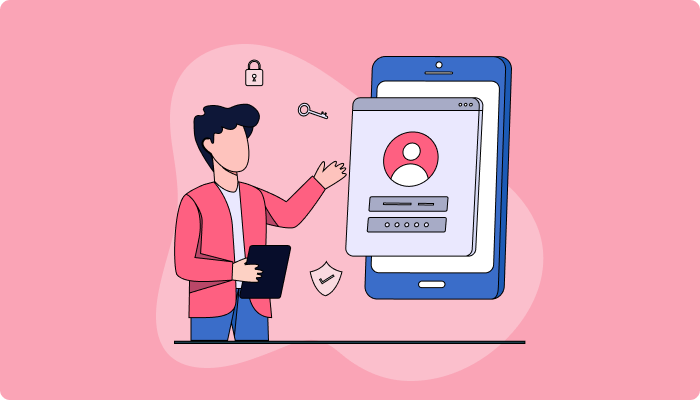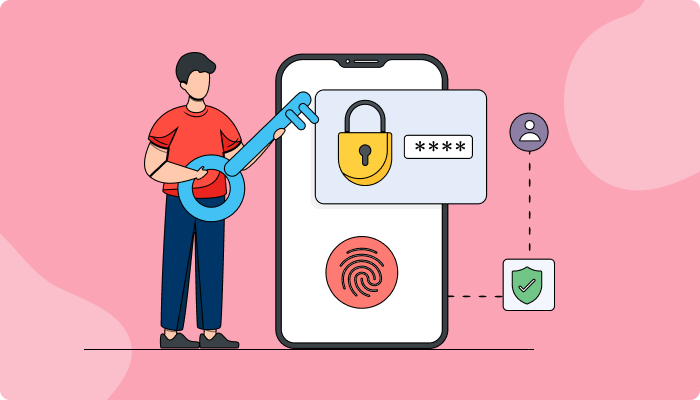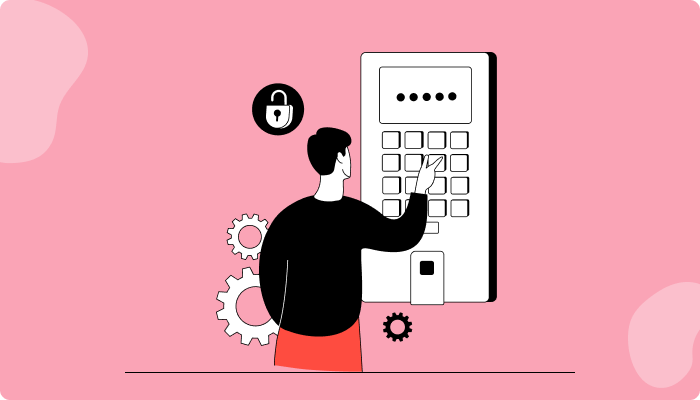OAuth Authentication: An Introduction and Its Advantages
In this article, we’ll explore the features of OAuth authentication, its key benefits, and why organizations should consider using it to stay competitive in today’s ever-evolving tech landscape. So if you’re ready to learn more about OAuth authentication, keep reading!

What is OAuth authentication, and how can it benefit your business? In today’s increasingly digital world, many businesses rely on secure online data access for their day-to-day operations. Understanding OAuth authentication is essential if you’re looking to protect customer information and maintain security.
OAuth (Open Authorization) is an open standard protocol that allows a user or organization to grant controlled access to resources without providing credentials such as usernames and passwords. This system enables users to authorize third-party applications to securely access the requested data from another service provider, allowing companies to improve their workflow efficiency while protecting sensitive customer details.
What Is OAuth Authentication?
OAuth authentication is a secure form of authorization that allows applications to access resources without storing and managing user passwords. It provides an OAuth Access Key, generated when the user grants permission for the application to access their data or perform certain actions on their behalf. This key then serves as a token between the two applications, allowing them to exchange information securely.
Using OAuth authentication also provides many advantages for developers looking to integrate different systems into one platform. For example, it offers flexibility in terms of authentication methods, meaning users can choose from multiple ways of verifying who they depend on the application's security requirements. Additionally, its protocol-based flow makes it easy to implement across various platforms while being incredibly secure. The tokens used in this process ensure that no confidential information is ever stored or sent through insecure channels, ensuring your data stays safe and private.

How OAuth Authentication Works?
OAuth authentication is an authorization protocol that allows users to securely access a web application or website using their existing account credentials. It allows the user to log into one app or site and then use those same credentials to sign in to other apps or sites without entering any new information. This way, OAuth authentication can be used for single sign-on across multiple services.
The resource owner (the user) sends a request to the client (the app making the request).
The client requests permission from the resource owner.
When granted, the resource owner sends a special code called an ‘access token’ back to the client via the server.
The client uses the access token as proof of permission from the resource owner.
The access token is passed along with each subsequent request sent out from app widgets on behalf of the user.
As we’ve seen here today, implementing OAuth authentication offers numerous advantages compared to traditional methods such as simple username/password combinations; these range from improved security and scalability to enhanced usability for end-users who no longer need to create separate accounts for every different service they wish to utilize on devices powered by app widgets like smartphones and tablets.
The Benefits Of OAuth Authentication
OAuth authentication offers a number of advantages for users and developers alike. It is much more secure than traditional methods, as it uses tokens instead of credentials to authenticate access. This means that user data is protected from malicious activity on the server side. Additionally, OAuth authentication allows users to grant limited access to their accounts without having to give away their passwords or other sensitive information. JSON Web Tokens (JWTs) can be used for authentication purposes in OAuth 2.0. JWT tokens are used to verify the identity of a user and can be used to authorize access to protected resources on a website. By using JWT tokens, you can ensure that only authorized users have access to your website’s resources.
Increased Security
OAuth authentication is a powerful security measure that provides users with added protection and peace of mind. It offers increased access control, allowing users to grant third-party applications limited access to their accounts without sharing passwords or other sensitive information. Applet.io is one such platform that uses OAuth authentication for user authorization. The benefits of using OAuth authentication are numerous:
Increased Security: Users can safely authorize third-party applications without needing to enter sensitive details like usernames and passwords.
Improved User Experience: Authorizing apps with OAuth is simple and straightforward, eliminating the need for lengthy forms.
Enhanced Data Protection: By limiting third-party apps’ access rights on an account level, data remains more secure than ever before. In short, implementing OAuth authentication in your application ensures a smoother experience for users while providing greater peace of mind for both them and you as the application provider.
Improved User Experience
OAuth authentication offers an improved user experience. Using OAuth, users can access their accounts and resources more quickly, with less effort than with traditional authentication methods. It also reduces the need to remember multiple usernames and passwords for different services. With Applet.io, it’s especially easy to start with OAuth since they offer an intuitive interface and built-in library for integrating applications with social networks like Google, Facebook, Twitter, etc.
Reduced Development Time And Costs
OAuth authentication is a cost-efficient and time-saving solution for app developers. It simplifies the user authorization process, which can be used to access multiple services without having to enter separate credentials each time. This means that users don’t have to remember different passwords or go through time-consuming logins every time they use an application.
Applet.io offers comprehensive integration with OAuth providers like Google, Facebook and Twitter so developers can take advantage of this technology in their applications. As no extra development effort is required on the developer's part, there are significant cost savings due to reduced manpower hours spent on building authorization mechanisms from scratch.
Flexibility And Compatibility
OAuth authentication offers an abundance of flexibility and compatibility. It is a widely adopted security protocol, making it easy to implement across multiple platforms. Moreover, the open-source nature of OAuth allows developers to customize the authorization process based on their own needs. For example, Applet.io uses OAuth to provide secure access control for its users. This helps reduce the time and money spent developing custom authentication solutions while ensuring that user data remains safe and secure.

Reduced Fraud And Identity Theft
OAuth authentication offers a great way to reduce fraud and identity theft. It is much more secure than most traditional authentication methods, like using passwords or pins. Here are the top four benefits Applet.io provides with OAuth:
Increased security: Since users don’t have to use a password or enter any personal information, there’s less chance for hackers to access sensitive data.
Reduced risk of phishing attacks: With OAuth, it’s harder for attackers to get their hands on user credentials since no personal info needs to be shared.
Improved user experience: Instead of remembering multiple usernames and passwords that need updating regularly, OAuth allows users to log in without hassle easily.
Enhanced privacy protection: By not sharing personal details online, users can rest assured knowing their data is safe from cybercriminals who might try to gain unauthorized access through stolen credentials.
OAuth authentication also helps ensure only legitimate users have access by verifying identities before granting authorization with various levels of verification depending on the service provider and application requirements. This ensures all accounts connected with an individual stay secure while providing better authentication options than other login systems available today.
Increased Access Control
OAuth authentication provides increased access control for users, allowing them to fully control the authorization process that happens when they sign up with an application. This allows users to choose which 3rd party services they want to share their data with while limiting fraudulent activity and identity theft. Applet.io is just one platform that benefits from OAuth authentication.
Seamless Integration With Third-Party Applications
OAuth authentication allows seamless integration with third-party applications. This type of authorization provides secure access to specific resources while granting users control over what they share. The OAuth protocol simplifies the process by eliminating the need for usernames and passwords when accessing an application. For example, Applet.io uses this technology to provide an easy way for users to log in using their existing credentials from another service, such as Google or Facebook.
Easy Revocation Of Access
OAuth authentication makes it easy to revoke access from third-party applications like Applet.io. With OAuth, users can quickly and easily take back control over their data by simply revoking access to the application in question. It’s a simple process that only takes a few clicks or taps of your finger, depending on your device.
Getting Started With OAuth Authentication
OAuth authentication is gaining traction as a simple and secure way to access data and services. It offers many benefits, including easy revocation of access.
Register Your Application With The OAuth Provider
Before using OAuth authentication (including with Applet.io), you must register your application with the OAuth provider. This process is straightforward and usually requires only a few basic details, such as your app name, URL, and contact information.
Once registered, the provider will then provide access tokens for different types of user data you may need to access. These tokens are used by your application in order to authenticate users properly when they log into or interact with the system. It also allows for more secure communication between the two systems since all requests from your application have to be approved by the token issuer before any action is taken.
The benefit of this type of authentication is that it provides an extra layer of security since each request has to be authorized before being allowed through. Additionally, having control over who can access certain parts of your application makes it easier to manage user permissions and protect confidential data stored within the system.
Authenticate The User
Authenticating a user with OAuth and Applet.io is simple and straightforward. First, you must get authorization from the user to access their account information. This can be easily done by providing them with an easy-to-use login page or a button that prompts them for authorization. Once they’ve granted your application access, here are the three simple steps to authenticate them:
Make an API call to the authentication provider (Applet.io in this case).
Exchange the provided code for an access token from Applet.io’s OAuth server.
Use the access token to make authorized requests on behalf of the user against Applet.io services.
This process allows users to securely grant permission without sharing confidential credentials like usernames and passwords with third-party applications like yours, ensuring great security and privacy protection of their data when accessing it through your app. Plus, users don’t have to remember multiple login details as they use a single set of credentials across all apps that support OAuth authentication system!
Exchange The Authorization Code For An Access Token
OAuth authentication is a secure way to authenticate users and protect their data. It provides the user with an additional layer of security, allowing them to use multiple accounts without entering credentials each time they log in. Applet.io uses OAuth as its primary form of authentication, so developers need to understand how authorization codes are exchanged for access tokens.
To exchange the authorization code for an access token with Applet.io, the user must provide certain information about themselves, such as an email address and password, which will be used by the application or website when requesting permission from Applet.io. Once this has been provided, Applet.io sends back an authorization code that can then be used to request an access token from the respective site or application.
Conclusion
OAuth authentication has become an increasingly popular method of securing private data access. OAuth is a simple protocol that allows users to securely give applications and websites access to their personal information without sharing passwords. By leveraging the strength of public key cryptography, OAuth provides improved security for user accounts by ensuring unauthorized third parties cannot gain access to sensitive account data.
In addition, OAuth also offers an improved user experience when accessing different services, as it eliminates the need for multiple logins on various sites or applications. This makes it easier and faster for users to use various applications while keeping their data secure. Furthermore, getting started with OAuth authentication is relatively straightforward, thanks to helpful guides like Applet.io, which walk you through each step, from registering your application with the provider up to exchanging authorization codes for tokens.
Why Choose 500apps?
Join the SaaS Revolution
-
All-in-One Suite of 50 apps
-
Unbelievable pricing - $14.99/user
-
24/5 Chat, Phone and Email Support
